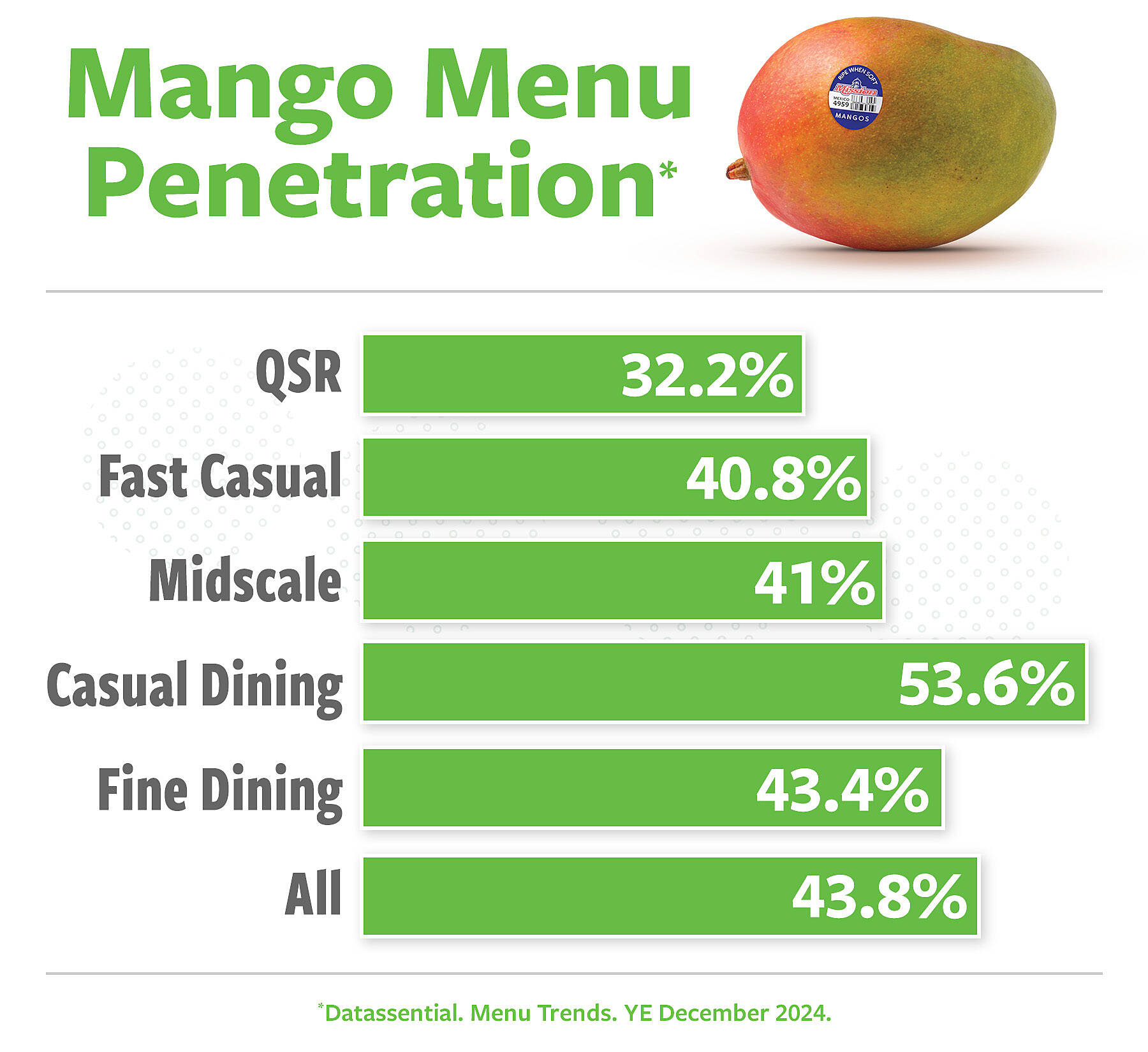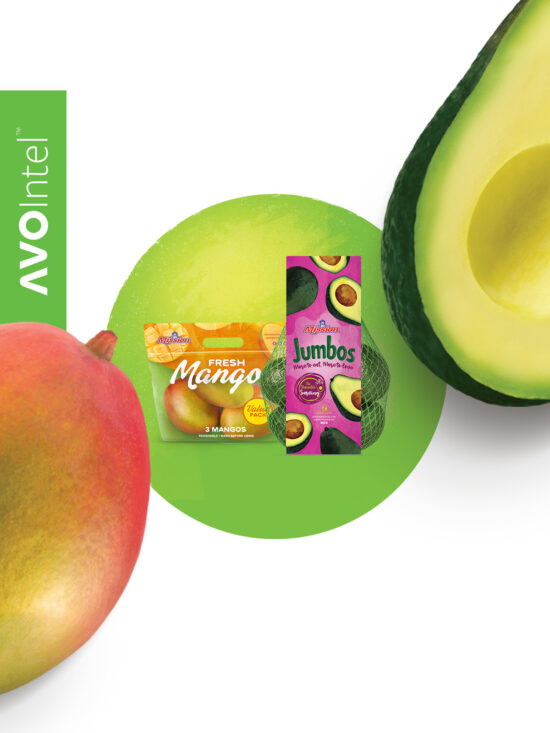
AvoIntel™: Make Room for Mangos on the Menu
From smoothie bowls to seafood tacos, mangos are gaining visibility across menus—and their culinary potential is just beginning to be tapped.
Mangos now appear on 44% of U.S. menus, with usage increasing across all foodservice segments, from fine dining and casual to fast casual and quick service restaurants (QSRs).1
This growth—up 11% between 2021 and 2024—points to mangos becoming a go-to ingredient for operators looking to introduce flavor-forward, versatile dishes.1
What’s Driving Mango Growth?
Health and versatility are two of the biggest factors.
In fact, two-thirds of U.S. consumers are actively seeking healthier food options,2 and 52% say the healthiness of food is highly important when deciding what to eat.3
For foodservice operators, that means nutrient-rich ingredients like mangos can play a meaningful role in menu development. A single serving (¾ cup) of mango delivers 50% of the Daily Value of vitamin C, supporting immune function and skin health.4,5 They also contain vitamins A, E, B6, copper, and folate—making them a strong contender for health-conscious menus.4,5
Chef Perspective: Amalia Scatena
Executive Chef Amalia Scatena, the chef behind our award-winning mango panna cotta, brings a thoughtful approach to incorporating mangos on the menu—using them to surprise and delight her guests.
“Mangos are incredibly versatile. They work just as beautifully in a savory application as they do in a dessert or cocktail– and not many ingredients can do both,” says Scatena. “That balance of sweet and subtle allows chefs to get creative and offer something that feels both familiar and unexpected on the plate, without overpowering the other flavors.”
Her advice for fellow chefs?
“Treat mangos as a stone fruit! Everything you can do with a peach—grill it, roast it, smoke it, shave it thin for a beautiful garnish—you can do with a mango. Its natural sweetness helps balance and elevate complex flavors, offering a fresh twist to any classic dish.”
Make Room for Mangos on the Menu
As foodservice champions new flavor trends and healthier menus, mangos are carving out space as a flexible, nutrient-rich ingredient with broad appeal. Their year-round availability, culinary adaptability, and growing consumer interest make them a timely addition to both menus and merchandising strategies.
From high-end kitchens to QSRs, mangos are making a lasting impression—and we expect this upward trend to continue.1
1Datassential. Menu Trends. YE December 2024.
2 Mintel. US Consumer Approach to Healthy Eating Report 2024.
3 Pew Research Center, “Americans on Healthy Food and Eating,” May 2025.
4National Mango Board. Mango Nutrition Handout. 2022.
5 U.S. Department of Agriculture, Agricultural Research Service. (2024). Mango, raw [FDC ID: 1102696].
*This blog is for informational purposes only. Any recommendations included herein shall not be construed as a guarantee of future results. We make no representation or warranties, and expressly disclaim any representations or warranties, as to the validity, accuracy, or completeness of the information contained herein.
Forward Looking Statements
Statements in this blog that are not historical in nature are forward-looking statements that, within the meaning of the federal securities laws, including the safe harbor provisions of the Private Securities Litigation Reform Act of 1995, involve known and unknown risks and uncertainties. Words such as "may", "will", "expect", "intend", "plan", "believe", "seek", "could", "estimate", "judgment", "targeting", "should", "anticipate", "goal" and variations of these words and similar expressions, are also intended to identify forward-looking statements. The forward-looking statements in this press release address a variety of subjects, including statements about our short-term and long-term assumptions, goals and targets. Many of these assumptions relate to matters that are beyond our control and changing rapidly. Although we believe the expectations reflected in such forward-looking statements are based upon reasonable assumptions, we can give no assurances that our expectations will be attained. Readers are cautioned that actual results could differ materially from those implied by such forward-looking statements due to a variety of factors, including: reliance on primarily one main product, limitations regarding the supply of fruit, either through purchasing or growing; fluctuations in the market price of fruit; increasing competition; risks associated with doing business internationally, including Mexican and Peruvian economic, political and/or societal conditions; inflationary pressures; establishment of sales channels and geographic markets; loss of one or more of our largest customers; general economic conditions or downturns; supply chain failures or disruptions; disruption to the supply of reliable and cost-effective transportation; failure to recruit or retain employees, poor employee relations, and/or ineffective organizational structure; inherent farming risks, including climate change; seasonality in operating results; failures associated with information technology infrastructure, system security and cyber risks; new and changing privacy laws and our compliance with such laws; food safety events and recalls; failure to comply with laws and regulations; changes to trade policy and/or export/import laws and regulations; risks from business acquisitions, if any; lack of or failure of infrastructure; material litigation or governmental inquiries/actions; failure to maintain or protect our brand; changes in tax rates or international tax legislation; risks associated with global conflicts; inability to accurately forecast future performance; the viability of an active, liquid, and orderly market for our common stock; volatility in the trading price of our common stock; concentration of control in our executive officers, and directors over matters submitted to stockholders for approval; limited sources of capital appreciation; significant costs associated with being a public company and the allocation of significant management resources thereto; reliance on analyst reports; failure to maintain proper and effective internal control over financial reporting; restrictions on takeover attempts in our charter documents and under Delaware law; the selection of Delaware as the exclusive forum for substantially all disputes between us and our stockholders; risks related to restrictive covenants under our credit facility, which could affect our flexibility to fund ongoing operations, uses of capital and strategic initiatives, and, if we are unable to maintain compliance with such covenants, lead to significant challenges in meeting our liquidity requirements and acceleration of our debt; and other risks and factors discussed from time to time in our Annual and Quarterly Reports on Forms 10-K and 10-Q and in our other filings with the Securities and Exchange Commission. You can obtain copies of our SEC filings on the SEC’s website at www.sec.gov.
The forward-looking statements contained in this blog are made as of the date hereof and the Corporation does not intend to, nor does it assume any obligation to, update or supplement any forward-looking statements after the date hereof to reflect actual results or future events or circumstances.











